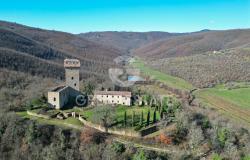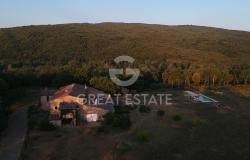Lazio
Rome, the capital city of Italy and the capital of the region of Lazio lies both at the centre of Italian political life and at the centre of the Catholic world since it encloses within it the tiny state of the Vatican. No wonder that the entire region is dominated by the history and the fame of the Eternal City.
Rome, once the centre of the Roman Empire, endured several barbaric invasions after the collapse of the empire, entering a long period of social and economical decline. As the empire declined, the city progressively became the centre of the Christian world and during the Renaissance, the pontifical court rearranged the city with the help of the greatest artists of the time. The city became a capital of the united Italy in 1871. The richness of the history of the city is visible in the splendid urban structure, the many wonderful buildings and churches, the eclectic mixture of architectural styles from the Etruscan to Classical Rome, from the Renaissance to the Baroque.
The region is also renown for its wonderful monasteries, such as the Abbey of Montecassino, the Abbey of San Benedetto and the Abbey of Casamari, as well as its villas and their gardens: the most curious of which is the Parco dei Mostri (the Park of the Monsters) in Bomarzo.
The geography of the region has a variety of features: the flat plains of the Roman and Pontino countryside are flanked by the mountains of the Lazio Pre-Apennines and the Abruzzo Apennines. The territory of the region was originally formed by the eruption of four volcanoes whose craters then became lakes. It is mostly a mixture of plains and hills, with mountains in the area of Rieti and in the north an area of lower mountains. The river Tiber flows through Lazio and is the third largest river in Italy after the Po and the Adige. Lake Bracciano, Bolsena and Albano are the main lakes of the region.
The economy of the region has developed with the growth in industry. Among the main industries are machinery manufacturing, metallurgy, chemicals, pharmaceuticals, textiles, food, paper, publishing, building and defence. Nevetheless, agriculture still plays an important role the main crops produced are cereal, fruit, vines and olive, and breeding sheep, pigs and cattle.
Memorable meals in the region of Lazio begin with variety of antipasti that include platters of frutti di mare, pizze, focacce, canapés, vegetable tarts, frittate with potatoes and onions, croquettes of rice, vegetables or meats, breads grilled and flavored with garlic and oil (bruschetta) or sliced and topped with meat and vegetable pastes or cheeses (crostini). Also typical are the spaghetti alla carbonara and bucatini all'amatriciana.
Among the many wonderful vegetables produced in the region are the famous Romano artichokes tender enough to eat raw, or to fry in the style of Rome's Jewish ghetto as carciofi alla giudia. Pecorino Romano DOP prevails among cheeses, though some is also produced in Sardinia and southern Tuscany.
The hills in the north of Lazio are noted for the production of extra virgin olive oils, protected under the DOPs of Canino and Sabina.
Pork is prized as porchetta, roasted by butchers in the Castelli Romani and sliced warm for sandwiches at the street markets. Many recipes rely on guanciale, salt pork from the jowl, though the traditional lard has been steadily replaced as a cooking fat by olive oil from the Sabine hills.
White wines dominate Lazio’s production, whose 23 DOCs are led by the versatile Frascati and Marino from the Castelli Romani and the mythical Est! Est!! Est!!! from Montefiascone to the north. Yet some of the finest wines are reds of Cerveteri, Velletri, a trio from the Cesanese vine or unclassified bottles based on Cabernet and Merlot.
Abruzzo
Abruzzo, in the souther-central part of Italy, is characterised by rocky mountains, vast forests, soft hilly landscapes and magnificent sandy beaches. Here you will find the highest peaks of the Apennines, the Gran Sasso (Monte Corno 9,560 feet), Maiella and Velino-Sirente, deep canyons and valleys, national and regional parks, wide sandy beaches, and a wealth of artistic and natural beauty. Citadels and castles appear in the middle of woods and pastures, in the parks with some luck you can see brown bears, wolves and chamois, and eagles, hawks and buzzards on the highest peaks.
Abruzzo is the most protected region in Italy, with 28% of its territory designated as park land: the Abruzzo National Park, the Gran Sasso and Monti della Laga National Parks, the Majella National Park, and the Sirente-Velino Regional Park.
The economy depends both on the commerce of agricultural products and on the growing craft sector (copper and wrought iron, lace, fabrics, wooden articles). The main agricultural areas are the pre-Apennine hills out near the coast, which produce mostly wheat, potatoes, vegetables, grapes, olives and fruit. Of importance are also the industrial crops of tobacco, sugar beets, saffron and liquorice.
The many artificial basins make the region the top producer of hydroelectric energy in the Apennines, which also has numerous methane and bauxite beds. Industry is mostly concentrated in the plains around Pescara, and Chieti and the main activities include electrochemical, electronics, paper and clothing.
The region has a varied cuisine combining fish based cooking with a more earthy cuisine. Shellfish, anchovies, mullet, octopus, cuttlefish are combined in the varied makings of brodetto (a peppery soup for which each port has its own version). Streams and lakes provide trout, eels and crayfish. The uplands of the Apennines produce outstanding artichokes, cardoons, beans, lentils and potatoes and the nation's main supply of saffron. Typical of the area was la panarda, a meal of 30 to 40 courses eaten through a day, which, sadly, is no longer in vogue.
Abruzzo produces one DOCG, Montepulciano d’Abruzzo Colline Teramano and three DOC wines, Contro Guerra, Trebbiano d'Abruzzo, Montepulciano d'Abruzzo. The regional wines used to be little known abroad and misjudged as cheap, generic, supermarket varieties. As with many other Italian wine producing regions of the South, this is changing and the region is undergoing a gradual transition from bulk-wine production to boutique wines.












